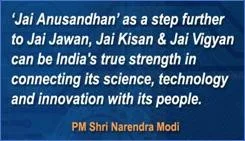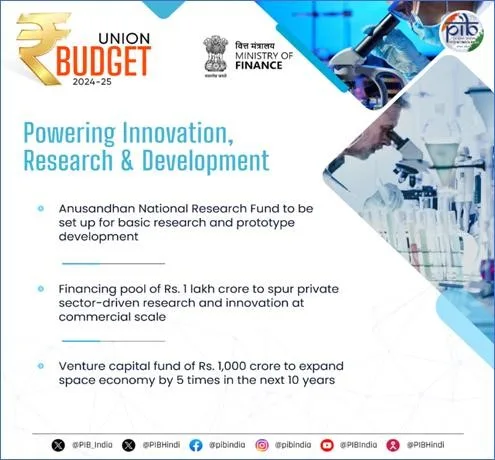Syllabus: GS 3/Science and Tech
In News
- Prime Minister Narendra Modi chaired the inaugural meeting of the Governing Board of the Anusandhan National Research Foundation (ANRF).

Key Points
- The meeting focussed on discussion about India’s Science and Technology landscape and redesigning of research and development programmes.
About ANRF
- The Anusandhan National Research Foundation (ANRF) was established under the ANRF Act 2023, with the goal of fostering a culture of research and innovation across India.
- The ANRF aims to seed, grow, and foster a culture of research and innovation throughout the country, as outlined in the National Education Policy (NEP).
- The Science and Engineering Research Board (SERB), which previously handled many of the country’s research funding activities, has been subsumed into ANRF.
- The ANRF has a funding target of ₹50,000 crore for the period 2023-2028.
Research and Development (R&D) Sector : Current Status
- India’s Gross Expenditure on Research and Development (GERD) increased from ₹6,01,968 million in 2010-11 to ₹12,73,810 million in 2020-21.
- R&D investment as a percentage of GDP is 0.64%, lower compared to major economies like China (2.4%), Germany (3.1%), South Korea (4.8%), and the U.S. (3.5%).
- India produces approximately 40,813 PhDs annually, ranking third globally.
- In 2022, India ranked third in research publications with over 3,00,000 outputs.
- India secured the sixth position in patent grants with 30,490 patents in 2022.
Importance
- Economic Growth: R&D is instrumental in driving economic growth by fostering innovation and enhancing productivity.
- Innovations stemming from R&D efforts can create new markets, generate employment opportunities, and increase the country’s GDP.
- Technological Advancement: Investments in R&D lead to the development of new technologies and processes that can improve efficiency across industries.
- Tackle National Challenges :R&D is vital for addressing pressing national challenges, including those related to health, agriculture, and environmental sustainability.
- Global Competitiveness : a strong R&D sector enhances a country’s competitiveness. India’s progress in research and development has led to significant improvements in its global rankings, such as advancements in the Global Innovation Index and Nature Index.
- Education and Skill Development :R&D activities also play a crucial role in promoting education and skill development.
Issues and Concerns
- India’s R&D expenditure is at 0.64% of GDP, down from 0.8% in 2008-09 and 0.7% in 2017-18.
- This is significantly lower compared to developed countries, which typically spend 2% to 4% of GDP on R&D.
- Current spending is heavily reliant on public funds, with private sector contributions only at 36.4%.
- Developed nations typically have over 70% of R&D funded by the private sector.
- Private sector funding is limited due to issues like unclear regulatory frameworks, lack of intellectual property protection, and poor evaluation capacity.
- The Economic Survey highlights the slow transition of technologies from lab to societal use, noting low ‘Land to Lab’ time as a key issue.
- Concerns have been raised about the adequacy of funding and the effective utilization of allocated resources.

Government Initiatives:
- The ₹50,000-crore National Research Foundation (NRF) fund was established in 2021 to promote interdisciplinary research.
- Anusandhan National Research Foundation (ANRF) :It has been established with Anusandhan National Research Foundation (ANRF) Act 2023.
- Private Sector-Driven Research and Innovation : The Indian government is providing substantial funding and creating a conducive environment to encourage private sector participation in R&D.
- Space Program Expansion: India’s space program has achieved significant milestones such as the Mars Orbiter Mission (Mangalyaan) and Chandrayaan missions.
- The government is now focusing on expanding the commercial potential of the space sector.
- Nuclear Energy Development: To meet growing energy demands and reduce carbon emissions, India is investing in small and modular nuclear reactors.
Conclusion and Way Forward
- Research and Development (R&D) serves as a crucial pillar for national growth and innovation, driving advancements in technology, industry, and science.
- India has made notable progress in R&D output, it needs to address funding gaps, increase private sector participation, and leverage recent policies to enhance its research and innovation ecosystem.
- Efforts must focus on equitable fund distribution, interdisciplinary collaborations, and maintaining global standards to advance India’s R&D capabilities.
Source:PIB
Previous article
Cyber Commandos to Deal With Cybercrime
Next article
News In Short-11-09-2024